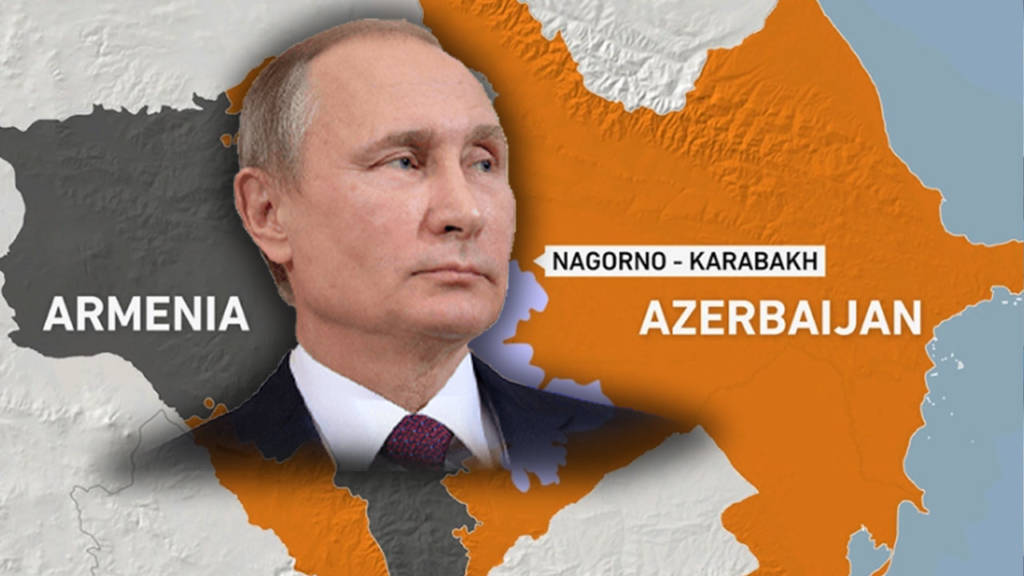Russian President Vladimir Putin on Wednesday said that although Armenia is part of Collective Security Treaty Organization (CSTO), the disputed region of Nagorno-Karabakh is not a part of it. This has created a slew of speculations and questions about what the role of Russia will be in the ongoing Azerbaijan-Armenia conflict.
The fight between Azerbaijan and Armenia regarding the disputed territory of Nagorno-Karabakh started on 27th September. Putin called this fighting in the southern Caucuses as a “Tragedy”. Putin said that Russia is treaty-bound and if the fight comes to Armenian territory, then it will honour the commitments by stepping in from the Armenian side.
But, Russia may not be ruling out the chance of entering the conflict in the Nagorno-Karabakh region. In the case of escalation, Russia might still intervene citing security threats to Russia as the region turns into a terror-breeding hub. This is the same justification used by Russia whilst entering the Syrian conflict.
Russia has proven time and again that it never tolerates any other country or organization trying to influence the region which was earlier part of the Soviet Union. The Russians will certainly not stay out of it. The region is geographically too important to let Turkey roll ahead with its plans successfully.
From the looks of it, Moscow is creating a solid case against Ankara before it moves ahead with its plans to teach Erdogan the lesson of his life so that the world understands that the erstwhile Soviet territories are Russia’s exclusive sphere of influence.
The recent news about radicalized Islamist mercenaries and terrorists heading towards the region of Karabakh has been concerning Russia.
The head of Russia’s SVR Foreign Intelligence Service, Sergei Naryshkin, said the conflict was attracting mercenaries and terrorists from the Middle East. He said, “We are talking about hundreds and already even thousands of radicals hoping to earn money in a new Karabakh war.”
Naryshkin warned about southern Caucusus region turning into a new launchpad for terrorist organisations.
This could threaten and compromise the Russian regions bordering southern Caucusus, and as there is a sizable Muslim population living there, it can worsen the situation pretty fast.
Syrian President Bashar al-Assad accused Erdogan of instigating the deadliest military conflict between Azerbaijan and Armenia since 1994, adding that Turkey is sending terrorists and mercenaries from Northern Syria. Assad said, “Damascus can confirm this.”
Thus, from the looks of it, Russia is going to follow the Syria model and may enter the southern Caucusus after creating a solid case of the possibility of the region turning into a new terrorist hotspot. Then provide support for anti-terrorist operations and if need be step-in with boots on the soil.
Turkey is in no mood to decelerate and diplomatically solve the dispute. Islamic mercenaries coming from Syria, Pakistan and Libya will turn the southern border of Russia into a terror hotspot. Moscow will surely be looking at starting their anti-terror operations and maintain the geopolitical status quo.
The Syria model may be tried in some sense, as in Syria, Putin argued that the status quo should not be destroyed. The argument makes sense as wherever there have been regime changes, the situation has gone far worse. The success of Russia in maintaining the status-quo in Syria was self-evident; thus any possibility of the origin of a terrorist organization in the bordering regions of Russian Caucusus will see aggressive reactions from Russia on right time.
Russia is most likely waiting for the right situation and all the proofs to mount before engaging in the region to counter Turkey’s Islamist fundamentalist fantasies, as Russia cannot engage in the Nagorno-Karabakh with the CSTO treaty because of the region being outside Armenia. The threat of terrorists coming into the southern Caucusus may have provided the required reason for Russia to enter into the military conflict in the southern Caucasus.
